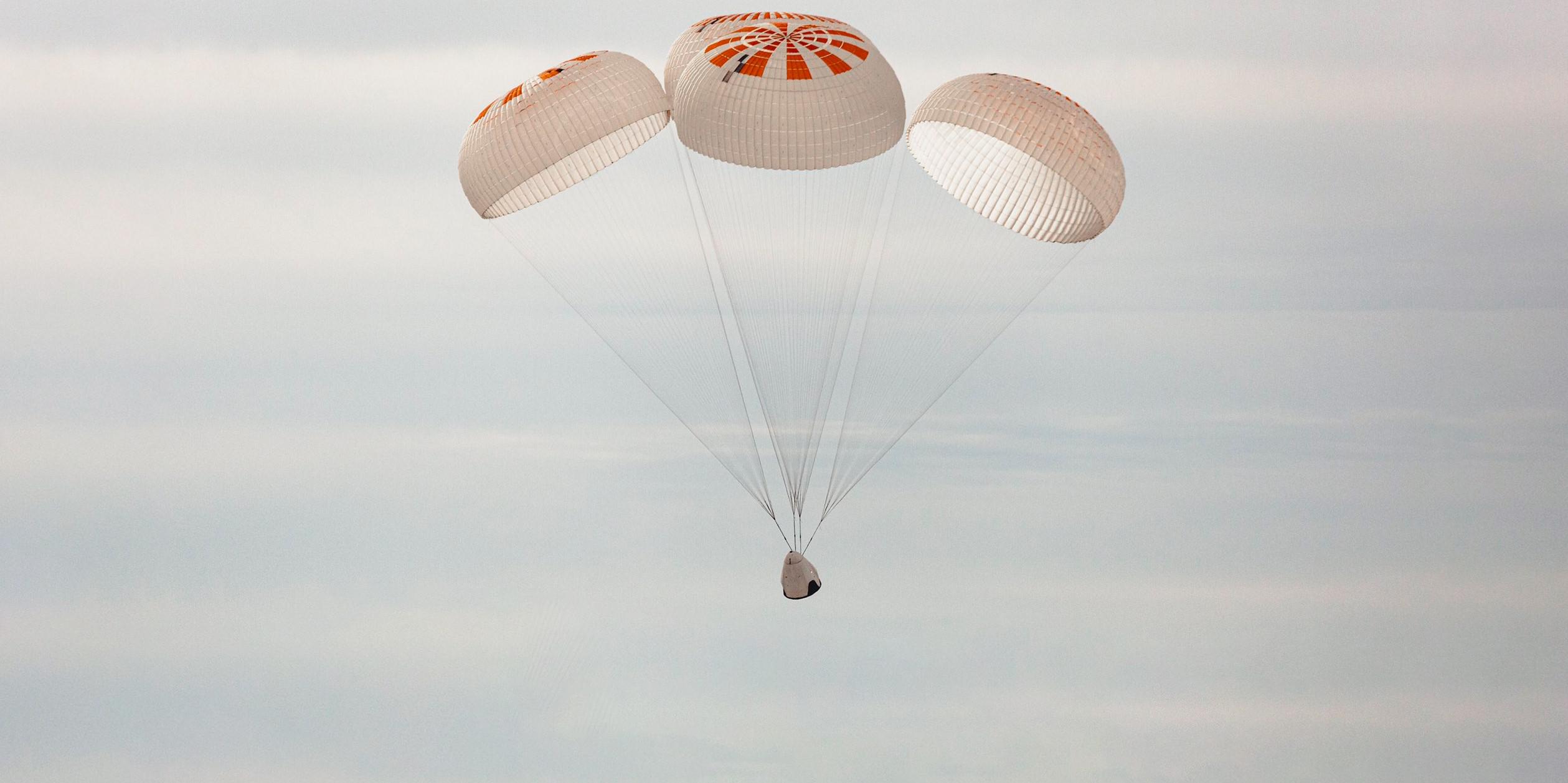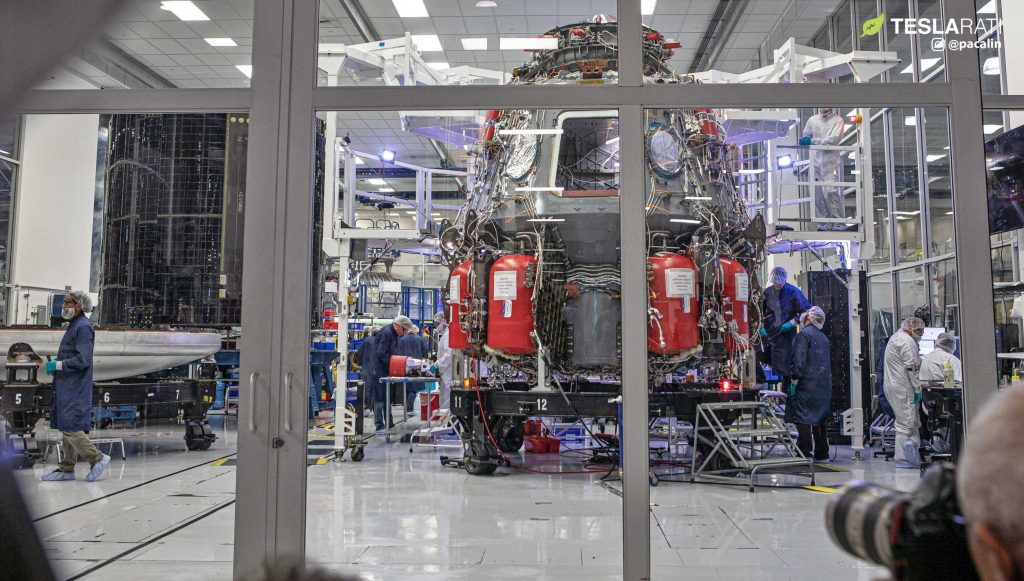

News
SpaceX leaps closer to launching NASA astronauts after parachute testing milestone
SpaceX says it has completed a test campaign of Crew Dragon’s upgrade parachutes, reaching a milestone that CEO Elon Musk recently described as a necessity before the spacecraft can be certified to launch NASA astronauts.
Beginning in late-October 2019, SpaceX kicked off an extensive test campaign of Crew Dragon’s recently-upgraded “Mark 3” parachute system, performing more than a dozen consecutively successful tests in a single week. SpaceX started with high-stress single-chute tests simulating far higher loads than Crew Dragon could ever technically exhibit in flight, resulting in two back-to-back failures.
SpaceX further improved the design with supplier Airborne Systems and began testing anew, successfully completing 10 single-chute tests in a row in a matter of days. Immediately after individual testing was completed as planned, SpaceX began multi-chute tests, initially simulating Crew Dragon’s ability to ensure a soft and survivable landing even if one of its four parachutes fully fails before splashdown.
Most recently, SpaceX announced on December 4th that it had completed the 7th consecutively successful multi-chute drop test, leaving three additional tests to go before reaching its goal of at least 10 consecutive successes.
Now, a bit less than three weeks after that 7th test, SpaceX says it has completed the 10th multi-chute drop test of Crew Dragon’s upgraded Mk3 parachutes, achieving the tentative goals set by CEO Elon Musk and NASA administrator Jim Bridenstine just two months ago. By the numbers, since Bridenstine first announced his expectation of “as many as 10 drop tests between now and the end of the year”, SpaceX alone has completed at least 20 successful tests in a row in the last eight weeks, averaging more than one test every three days.
“We could see as many as 10 drop tests between now and the end of the year and depending on how the next 10 drop tests go, we will know how many more drops tests we are going to add.”
Jim Bridenstine, October 10th, 2019
As Bridenstine indicated, this does not necessarily guarantee that NASA, SpaceX, or both entities won’t choose to perform additional tests, but a full 20 successful parachute tests in a row is an undeniable sign that Crew Dragon’s latest upgrades are bearing fruit. In simpler terms, SpaceX and Crew Dragon should be closer than ever to achieving the requirements NASA has laid out to certify spacecraft for human spaceflight.
With a successful orbital launch and recovery (including parachutes) already under its belt, Crew Dragon’s next milestone – scheduled to launch no earlier than (NET) January 11th – is a suborbital In-Flight Abort (IFA) test that will technically serve as the second full-system recovery test. If that launch, abort, and Atlantic Ocean contingency splashdown go as planned, there is a very good chance that NASA will finally close out SpaceX’s parachute systems for Crew Dragon’s first crewed launch.


Known as Demo-2, SpaceX has said that the mission’s Falcon 9 and Crew Dragon hardware will be ready for launch as early as late-December. If Dragon’s IFA test and any additional subsystem tests run into problems, Demo-2 hardware will of course no longer be ready, per se, but if those tests are completed without issue, SpaceX has indicated that Crew Dragon’s first astronaut launch could follow as soon as February or March 2020.
The road to SpaceX’s first human launch has been long and winding, but – barring calamity – the milestone appears, at long last, to be well within reach. Accounting for potential technical or NASA paperwork-related delays, it’s extremely likely that the first NASA astronauts will be at the helm of a Crew Dragon spacecraft on top of a Falcon 9 rocket less than six months from now.
Check out Teslarati’s Marketplace! We offer Tesla accessories, including for the Tesla Cybertruck and Tesla Model 3.

Elon Musk
Elon Musk and Tesla AI Director share insights after empty driver seat Robotaxi rides
The executives’ unoccupied tests hint at the rapid progress of Tesla’s unsupervised Robotaxi efforts.

Tesla CEO Elon Musk and AI Director Ashok Elluswamy celebrated Christmas Eve by sharing personal experiences with Robotaxi vehicles that had no safety monitor or occupant in the driver’s seat. Musk described the system’s “perfect driving” around Austin, while Elluswamy posted video from the back seat, calling it “an amazing experience.”
The executives’ unoccupied tests hint at the rapid progress of Tesla’s unsupervised Robotaxi efforts.
Elon and Ashok’s firsthand Robotaxi insights
Prior to Musk and the Tesla AI Director’s posts, sightings of unmanned Teslas navigating public roads were widely shared on social media. One such vehicle was spotted in Austin, Texas, which Elon Musk acknowleged by stating that “Testing is underway with no occupants in the car.”
Based on his Christmas Eve post, Musk seemed to have tested an unmanned Tesla himself. “A Tesla with no safety monitor in the car and me sitting in the passenger seat took me all around Austin on Sunday with perfect driving,” Musk wrote in his post.
Elluswamy responded with a 2-minute video showing himself in the rear of an unmanned Tesla. The video featured the vehicle’s empty front seats, as well as its smooth handling through real-world traffic. He captioned his video with the words, “It’s an amazing experience!”
Towards Unsupervised operations
During an xAI Hackathon earlier this month, Elon Musk mentioned that Tesla owed be removing Safety Monitors from its Robotaxis in Austin in just three weeks. “Unsupervised is pretty much solved at this point. So there will be Tesla Robotaxis operating in Austin with no one in them. Not even anyone in the passenger seat in about three weeks,” he said. Musk echoed similar estimates at the 2025 Annual Shareholder Meeting and the Q3 2025 earnings call.
Considering the insights that were posted Musk and Elluswamy, it does appear that Tesla is working hard towards operating its Robotaxis with no safety monitors. This is quite impressive considering that the service was launched just earlier this year.
Elon Musk
Starlink passes 9 million active customers just weeks after hitting 8 million
The milestone highlights the accelerating growth of Starlink, which has now been adding over 20,000 new users per day.

SpaceX’s Starlink satellite internet service has continued its rapid global expansion, surpassing 9 million active customers just weeks after crossing the 8 million mark.
The milestone highlights the accelerating growth of Starlink, which has now been adding over 20,000 new users per day.
9 million customers
In a post on X, SpaceX stated that Starlink now serves over 9 million active users across 155 countries, territories, and markets. The company reached 8 million customers in early November, meaning it added roughly 1 million subscribers in under seven weeks, or about 21,275 new users on average per day.
“Starlink is connecting more than 9M active customers with high-speed internet across 155 countries, territories, and many other markets,” Starlink wrote in a post on its official X account. SpaceX President Gwynne Shotwell also celebrated the milestone on X. “A huge thank you to all of our customers and congrats to the Starlink team for such an incredible product,” she wrote.
That growth rate reflects both rising demand for broadband in underserved regions and Starlink’s expanding satellite constellation, which now includes more than 9,000 low-Earth-orbit satellites designed to deliver high-speed, low-latency internet worldwide.
Starlink’s momentum
Starlink’s momentum has been building up. SpaceX reported 4.6 million Starlink customers in December 2024, followed by 7 million by August 2025, and 8 million customers in November. Independent data also suggests Starlink usage is rising sharply, with Cloudflare reporting that global web traffic from Starlink users more than doubled in 2025, as noted in an Insider report.
Starlink’s momentum is increasingly tied to SpaceX’s broader financial outlook. Elon Musk has said the satellite network is “by far” the company’s largest revenue driver, and reports suggest SpaceX may be positioning itself for an initial public offering as soon as next year, with valuations estimated as high as $1.5 trillion. Musk has also suggested in the past that Starlink could have its own IPO in the future.
News
NVIDIA Director of Robotics: Tesla FSD v14 is the first AI to pass the “Physical Turing Test”
After testing FSD v14, Fan stated that his experience with FSD felt magical at first, but it soon started to feel like a routine.

NVIDIA Director of Robotics Jim Fan has praised Tesla’s Full Self-Driving (Supervised) v14 as the first AI to pass what he described as a “Physical Turing Test.”
After testing FSD v14, Fan stated that his experience with FSD felt magical at first, but it soon started to feel like a routine. And just like smartphones today, removing it now would “actively hurt.”
Jim Fan’s hands-on FSD v14 impressions
Fan, a leading researcher in embodied AI who is currently solving Physical AI at NVIDIA and spearheading the company’s Project GR00T initiative, noted that he actually was late to the Tesla game. He was, however, one of the first to try out FSD v14.
“I was very late to own a Tesla but among the earliest to try out FSD v14. It’s perhaps the first time I experience an AI that passes the Physical Turing Test: after a long day at work, you press a button, lay back, and couldn’t tell if a neural net or a human drove you home,” Fan wrote in a post on X.
Fan added: “Despite knowing exactly how robot learning works, I still find it magical watching the steering wheel turn by itself. First it feels surreal, next it becomes routine. Then, like the smartphone, taking it away actively hurts. This is how humanity gets rewired and glued to god-like technologies.”
The Physical Turing Test
The original Turing Test was conceived by Alan Turing in 1950, and it was aimed at determining if a machine could exhibit behavior that is equivalent to or indistinguishable from a human. By focusing on text-based conversations, the original Turing Test set a high bar for natural language processing and machine learning.
This test has been passed by today’s large language models. However, the capability to converse in a humanlike manner is a completely different challenge from performing real-world problem-solving or physical interactions. Thus, Fan introduced the Physical Turing Test, which challenges AI systems to demonstrate intelligence through physical actions.
Based on Fan’s comments, Tesla has demonstrated these intelligent physical actions with FSD v14. Elon Musk agreed with the NVIDIA executive, stating in a post on X that with FSD v14, “you can sense the sentience maturing.” Musk also praised Tesla AI, calling it the best “real-world AI” today.








